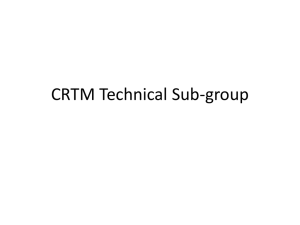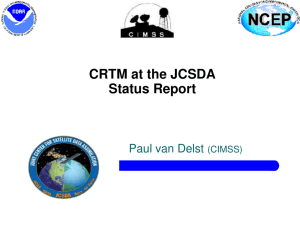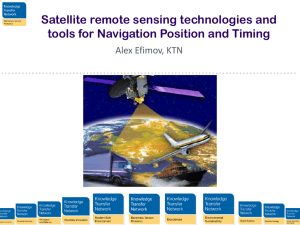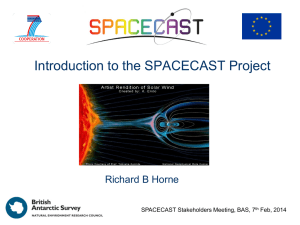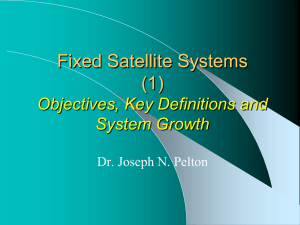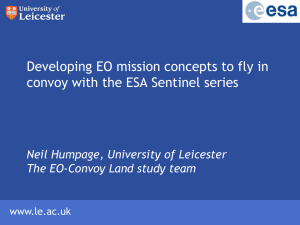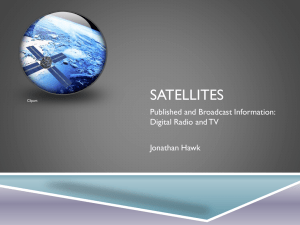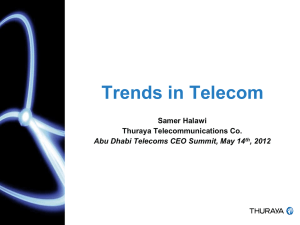CRTM_Overview_2011_HIWWG_Chen
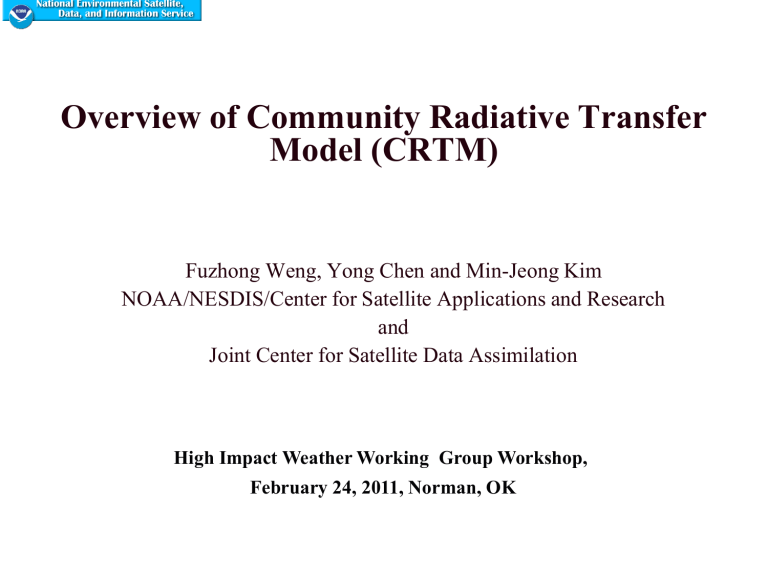
Overview of Community Radiative Transfer
Model (CRTM)
Fuzhong Weng, Yong Chen and Min-Jeong Kim
NOAA/NESDIS/Center for Satellite Applications and Research and
Joint Center for Satellite Data Assimilation
High Impact Weather Working Group Workshop,
February 24, 2011, Norman, OK
CRTM Application Areas
•
CRTM was initially proposed to support primarily the JCSDA partners to assimilate satellite radiance data into global/regional forecast systems
•
It is now also supporting the US satellite program developments through generating a high quality proxy data for algorithm tests, developments and integrations
•
It has been used in the NOAA/NESDIS microwave sounding product system
•
It can be used to generate the synthetic satellite radiances from NWP nature runs for observation system simulation experiments
(OSSE)
•
It is linked to other key projects such as climate reanalysis and satellite cal/val
Joint Center for Satellite Data
Assimilation (JCSDA)
Partner Organizations
2
Requirements on CRTM
•
Perform fast and accurate forward, tangent linear/adjoint calculations
•
Support all the satellite instruments
(US and foreign) that are used in
NWP models
•
Work under all atmospheric and surface conditions
•
Have a flexible interface with different NWP models such as
GFS, NOGAPS, and WRF
•
Allow future expansion for broader applications
CRTM supports more than 100 Sensors
•
GOES-R ABI
•
Metop IASI/HIRS/AVHRR/AMSU/MHS
•
TIROS-N to NOAA-19 AVHRR
•
TIROS-N to NOAA-19 HIRS
•
GOES-8 to 14 Imager
•
GOES-8 to 14 sounder IR channel 08-13
•
Terra/Aqua MODIS Channel 1-10
•
MSG SEVIRI
•
Aqua AIRS, AMSR-E, AMSU-A,HSB
•
NOAA-15 to 19 AMSU-A
•
NOAA-15 to 17 AMSU-B
•
NOAA-18/19 MHS
•
TIROS-N to NOAA-14 MSU
•
DMSP F13 to15 SSM/I
•
DMSP F13,15 SSM/T1
•
DMSP F14,15 SSM/T2
•
DMSP F16-20 SSMIS
•
Coriolis Windsat
•
TiROS-NOAA-14 SSU
•
FY-3 IRAS, MWTS,MWHS,MWRI
•
NPP/JPSS CrIS/ATMS
3
Highlights on CRTM Software Architecture, Sciences and Physical Processes
•
Atmospheric gaseous absorption
Band absorption coeff trained by LBL spectroscopy data with sensor response
functions
Variable gases ( H
2
O, CO
2
, O
3 etc) .
Zeeman splitting effects near 60 GHz
•
Cloud/precipitation scattering and emission
Fast LUT optical models at all phases including non-spherical ice particles
Gamma size distributions
•
Aerosol scattering and emission
GOCART 5 species (dust, sea salt, organic/black carbon, )
Lognormal distributions with 35 bins
•
Surface emissivity/reflectivity
Two-scale microwave ocean emissivity
Large scale wave IR ocean emissivity
Land mw emissivity including vegetation and snow
Land IR emissivity data base
•
Radiative transfer scheme
Tangent linear and adjoints
Inputs and outputs at pressure level coordinate
Advanced double and adding scheme
Other transfer schemes such as SOI, Delta
Eddington
“Technology transfer made possible by CRTM is a shining example for collaboration among the JCSDA Partners and other organizations, and has been instrumental in the JCSDA success in accelerating uses of new satellite data in operations” – Dr. Louis Uccellini, Director of
National Centers for Environmental Prediction
4
CRTM Infrared Spectroscopy
Corresponding to AIRS, IASI and CrIS
CRTM simulated brightness temperature (BT) spectrum for hyper-spectral infrared sensors IASI (black line), AIRS (red line), and CrIS (blue line).
5
CRTM Validation
using CloudSat data (non-precipitating weather)
CloudSat Data Set NCEP, ECMWF Data Set
Cloud profiles
( IWC, LWC)
Atmospheric profiles, surface conditions
Radiances and Brightness
Temperatures
CRTM Forward Model
Satellite zenith angles,
Solar zenith angles
Coincidental/Collocated Satellite
Data Set
Bias calculations and analysis, find the causes for the biases in the context of radiative physics and improve the CRTM performance.
6
Simulations Using Cloudsat Data and GDAS Profiles
•
Cloudsat data are averaged along the track of NOAA-18 satellite within each AMSU,
MHS and AVHRR IFOVs and then used as inputs to
CRTM
•
GDAS temperatures and water vapor profiles matched with Cloudsat profiles
•
Simulations are compared with NOAA-18 AMSU-A,
MHS, AVHRR observations
•
It is shown that both bias and
RMS errors are reduced with
Cloudsat data used in CRTM
AMSUA FOV (~50km diameter)
MHS
FOV
CloudSat FOV
~50 CloudSat FOVs
AVHRR FOV (GAC)
~4km diameter
(Chen et al., 2008, JGR) 7
Histograms of the Observed and Simulated for
AMSUA, MHS BTs over Ocean
Observation
Simulation
Reasonable agreements of observed and simulated BT distributions at all frequencies.
8
Histograms of the BT Difference (Observation – Simulation) over
Ocean under Clear and Cloudy Conditions
Cloudy
Clear
•
The distributions are in
Gaussian shapes with maximum observation at or near zero, which confirm that the agreement between observed and simulated BTs are very good under clear and cloudy conditions.
•
There are clear-sky biases in certain surface sensitive microwave channels of the order of 1–2 K which is due to the sea-surface emission model used in CRTM.
9
CRTM Jacobian Calculations Compared with RTTOV
•
RTTOV is another fast radiative transfer model used by NWP community for satellite data assimilation
•
Radiance Jacobians at 6.2 and 7.2 micron water vapor channels
(GOES-R ABI and MSG
SEVIRI) are derived from CRTM
& RTTOV
•
Both models produce Jacobian profiles peaked at the same altitude
•
But the magnitudes are slightly different between two fast models
Assumption: surface emissivity =
0.98, local zenith angle = 0 deg., and skin temperature = 300 K
10
Inter-comparison of CRTM with RTTOV at MSG SEVIRI Water Vapor Channels
Simulated vs observed brightness temperatures using 457 radiosonde profiles
11
CRTM Simulated GOES-R ABI Visible Channel
Using WRF-Chem Model Outputs
GOESR ABI 0.64 µm
1.
Hourly GOES-R ABI proxy data simulated for the period of 10:00 UTC 24 to 03 UTC 25 August 2006 is produced with WRF-Chem air quality simulations and visible-enabled version of the CRTM.
2.
The dataset covers CONUS domain with all 16 ABI bands. The high resolution
(4km) aerosol and ozone data sets have been created over the continental US.
3.
Compared with MODIS observations, simulated reflectance over land appears lower than observed and cloud reflectance is somewhat brighter
MODIS 0.645 µm
Brad Pierce, 2009, GOES-R AWG workshop
12
Microwave Surface Emissivity Models in CRTM
•
Oceans
– two-scale roughness theory
•
Sea ice
– Coherent reflection
•
Canopy
– Four layer clustering scattering
•
Bare soil
– Coherent reflection and surface roughness
• Snow/desert – Random media
Weng et al (2001, JGR)
Surface Emissivity Spectra (
=53
0
)
1.0
0.9
0.8
0.7
0.6
0.5
0.4
0.3
0.2
0 20 40 60 80 100 120 140 160 180 200
Frequency (GHz)
Snow
Canopy
Bare Soil
Wet Land
Desert
Ocean
Surface Emissivity Spectra (
=53
0
)
1.0
0.9
0.8
0.7
0.6
0.5
0.4
0.3
0.2
0 20 40 60 80 100 120 140 160 180 200
Frequency (GHz)
13
Snow
Canopy
Bare Soil
Wet Land
Desert
Ocean
Infrared Land Emissivity Data Base in CRTM
14
CRTM Applications in GOES-R Retrieval Algorithms
15
Progress in Cloudy Radiance Assimilation
CRTM was implemented in NCEP GSI for clear sky satellite data assimilation and will be used for cloudy radiance assimilation
Need to ensure a best trade-off between accuracy and computational efficiency
T o achieve improved forecast scores through cloudy radiance assimilation, we need:
Linearity of models
Appropriate background and observation errors
Error statistics (non-Gausian vs. Gausian pdf)
Quality control
Representativeness of observations and model
Bias correction
•
The fundamental works such as bias characterization, observation error covariance in cloudy conditions just started.
16
AMSU Observation – Background (O-B) from GFS
Clear and cloudy sky over the ocean Clear sky over the ocean
O-B pdfs for all sky conditions appear very similar to those for clear-only conditions
17
First Guess Departure as a Function of Cloud Liquid Water
Using average CLW, it seems that the bias is less dependent on cloud liquid water which will simplify the bias correction algorithm in GFS
18
Observation Error Covariance as a Function of Cloud Liquid Water
13 K 7K
9 K
10 K
1.3 K
0.55 K
However, observation error covariances remain highly dependent on CLW
19
Summary and Conclusions
•
A new generation of radiative transfer model (Community
Radiative Transfer Model (CRTM)) has been developed for the
JCSDA partner’s NWP satellite data assimilation
•
CRTM Version 2 upgrades include radiance calculations in pressure coordinate, new microwave snow and sea ice emissivity, trace gas absorption, aerosol scattering and absorption
•
Independent assessments indicate an excellent performance of
CRTM in both forward and Jacobian computations
•
O-B bias and error covariance from CRTM in GFS under cloudy conditions are characterized for AMSU with which the AMSU cloudy radiances will be first tested for impact studies
20
